Discover Udemy, the renowned online platform that enables instructors to build engaging courses covering a multitude of disciplines. With its user-friendly interface and global reach, Udemy empowers educators to share their expertise while offering learners an extensive catalog of courses tailored to diverse interests and skill levels.
In this Udemy review, we delve into the online course platform’s robust features, educational benefits, and how it serves as a gateway to acquiring new knowledge.
What is Udemy?
Udemy is a leading e-learning platform that offers a vast array of online courses across various subjects, making it a prime choice for both learners and instructors. Founded in 2010, Udemy has grown to become one of the most popular destinations for individuals seeking to enhance their skills, learn new hobbies, or advance their careers. The platform hosts over 150,000 courses, taught by expert instructors from around the world.
One of the standout features of Udemy for instructors is its accessibility. Whether you’re teaching beginners or advanced learners, the e-learning platform allows you to create courses tailored to meet various educational needs. Courses can be offered in multiple languages, enabling instructors to reach a global audience and share their expertise widely.
Udemy’s course categories range from programming and IT to personal development and arts. This diversity ensures that instructors can find a niche that matches their expertise. Each course typically includes video lectures, quizzes, and assignments, providing instructors with a comprehensive framework to deliver their content effectively.
Unlike traditional educational institutions, the platform allows instructors to design courses that students can progress through at their own pace. This self-paced learning model is ideal for reaching busy professionals, students, and anyone with a hectic schedule.
Another notable advantage of Udemy for instructors is its monetization opportunities. The platform frequently runs promotions and discounts, making high-quality education accessible while still providing instructors with the potential to earn substantial revenue. This affordability, combined with the platform’s extensive reach, makes Udemy an attractive choice for instructors looking to share their knowledge and skills.
Pricing
Creating an account and courses on Udemy is free. However, if you want to sell your courses, you need to become a premium instructor.
Premium Instructor
There is no fee to become a premium instructor; you simply need to submit an application, which will be reviewed and answered within two business days.
The application process starts after you build your course and set its price. Afterward, you will need to provide some personal information, such as your name, a profile picture, and a short bio, as well as a description of your expertise.
By becoming a premium instructor, you will benefit from Udemy’s revenue-sharing model. When a student purchases a course through your promotional link, you will earn 97% of the revenue. For sales made through Udemy’s organic search or marketing efforts, you will receive 37% of the revenue.
Udemy Business
Udemy Business is a B2B learning solution aimed at addressing workforce development needs within organizations.
To enroll in Udemy Business, instructors must opt into the program via the Premium Instructor Application. Once enrolled, instructors benefit from enhanced exposure to corporate clients seeking professional development resources.
Courses selected for Udemy Business are chosen based on factors like student feedback, engagement metrics, and alignment with business needs, ensuring a curated collection of high-quality content.
Course Types
Embarking on your journey to create your first course on Udemy opens up a world of possibilities in online education. Whether you’re an expert in a niche topic or passionate about sharing your skills, Udemy provides a platform to reach a global audience of learners eager to enrich their knowledge.
There are two types of courses on Udemy:
- Courses: These enable you to create comprehensive learning experiences with video lectures, quizzes, exercises, and more.
- Practice Tests: Designed to assist students in preparing for certification exams by providing targeted practice questions and assessments.

After selecting a name for your course, you will need to choose a category from a list provided by Udemy.

Course Creation
Before you begin creating your course, you need to provide information that describes the intended audience, visible on your course landing page.
Define Your Intended Learners
You need to specify at least four learning objectives outlining what learners will achieve and the skills they will acquire. Then, you must list any requirements or prerequisites necessary for taking the course—such as previous experience or knowledge. Lastly, you’ll need to clearly define the target audience for whom this course is designed.

Udemy provides tips to help you carefully define your course structure for effective student guidance and optimize your video setup.
When creating a course on Udemy, you will have to define clear learning objectives and organize content into sections with concise lectures and practical activities. Start with a compelling introduction, outline specific learning goals for each section, and maintain focused lectures between 2 to 7 minutes in length.
Use a variety of teaching formats to keep learners engaged, ensuring your course meets Udemy’s quality standards with at least five lectures and 30 minutes of educational video content, free from promotional material.
You should organize your recording environment with a neat backdrop and minimal props, such as colored paper or a plain sheet to improve the quality of your course videos.
Captions and Accessibility
To ensure your courses are accessible in multiple regions, Udemy lets you to add captions to your lectures in different languages.

Moreover, Udemy offers accessibility guidelines to help you ensure that course content is usable and beneficial for people with disabilities, including those with temporary or situational impairments. By planning for accessibility, instructors can create content that broadens their reach and meets requirements for higher education or government agencies.
Organize Your Lectures
Udemy allows you to easily create and organize your course by dividing it into multiple sections, each containing lectures or practice activities.
You can also diversify your lecture formats by incorporating various multimedia elements, such as videos, a mix of video and slides, and articles.

You can add multiple files using the Bulk Uploader, which allows you to upload from various sources such as your local computer, Google Drive, or Dropbox.
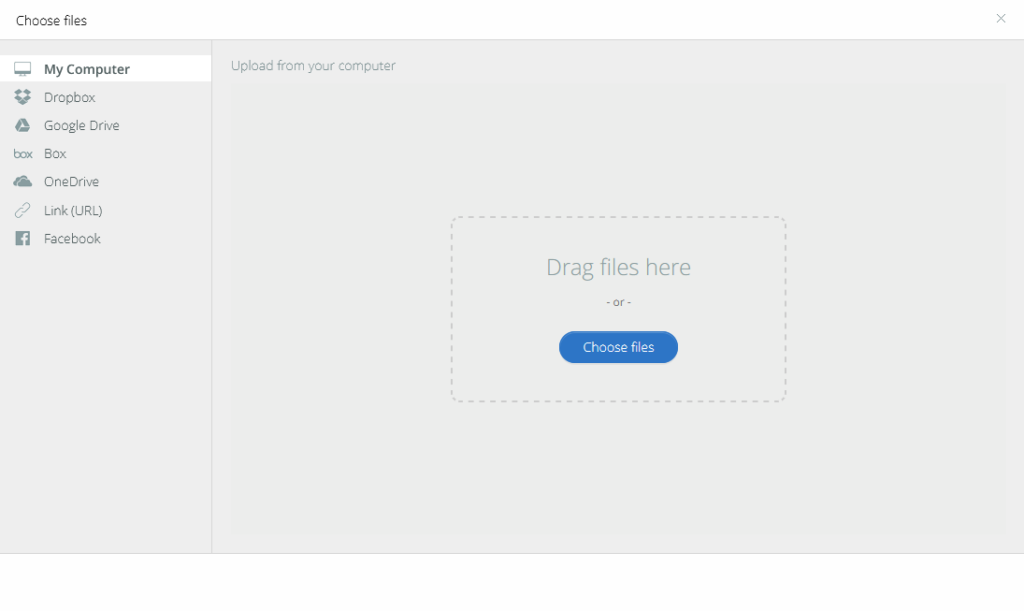
Video
After uploading a video, you can decide whether it will be downloadable or not, and you will be asked to add a description and include any relevant resources.
Adding relevant resources to your course videos enhances the learning experience by providing additional materials that support and reinforce the content. Resources such as PDFs, worksheets, links, and supplementary readings offer students a deeper understanding of the topic and practical tools to apply their knowledge.
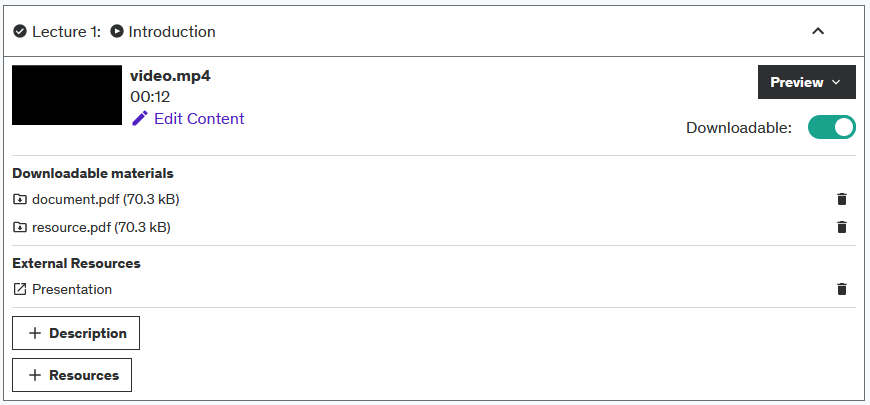
You can add resources from multiple sources, such as uploading a file, adding from a library, linking to a URL, and even including source code files that currently support Python and Ruby.

At any time, you can preview your lesson as either a student or an instructor to ensure it meets your expectations. You can also test downloading the files you have added as resources. This functionality allows you to experience the course from the learner’s perspective, ensuring all content and resources are accessible and functioning correctly.
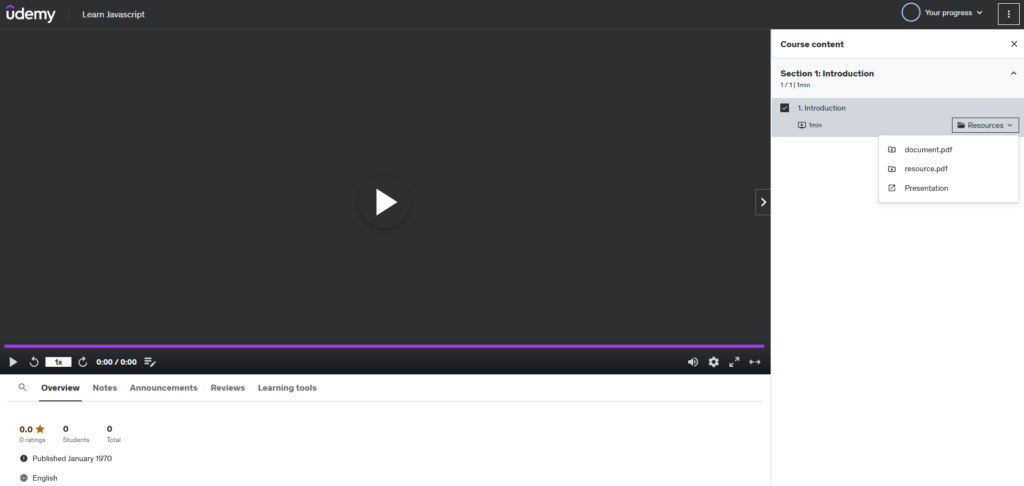
Video and slides
Udemy allows you to personalize your course content by adding a mix of videos and presentation slides.

After selecting the video and presentation, you will be prompted to choose the order in which your slides and video sequences will be presented. This allows you to structure your content logically, ensuring a smooth and coherent flow of information.

You can preview the flow you choose to ensure everything appears as you like and change it at any time.

Similar to the video content, you can add resources to complete your course.
Articles
Beyond multimedia content, Udemy provides the option to enhance your course with articles. This feature allows you to customize text styles, embed external links, include code blocks, and incorporate images.
Articles are ideal for providing detailed explanations, references, or additional resources that enrich the learning experience and offer deeper insights into course topics.

You can preview your article at any time to ensure that all aspects, including content, layout, and multimedia elements, appear as intended before making it available to students.
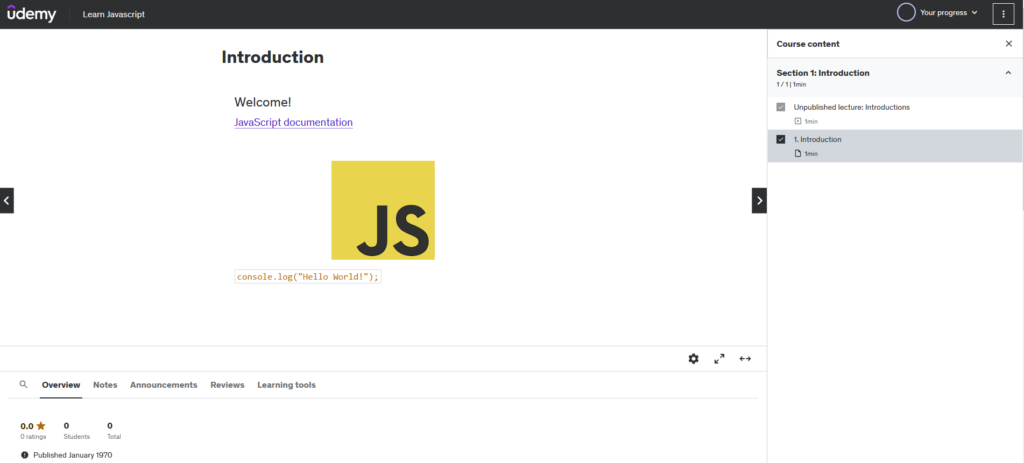
Additional Interactive Content
Apart from the lectures that represent the core content of your course, you can also add other types of section items such as quizzes, coding exercises, practice tests, and assignments. It’s important to note that to create a practice test, you must set a price for your course, which requires completing the premium instructor application process.

Quiz
In Udemy, creating multiple-choice quizzes is intuitive and straightforward. For each question, you can add as many answers as you like and provide explanations to clarify why each answer is correct or incorrect, helping your students understand better. You can also link each quiz to the related lecture to reinforce learning connections.

Just like lectures, you can preview and test your quiz at any time.

Coding Exercise
For a course topic related to development, you have the capability to create coding exercises that enable students to apply theoretical knowledge interactively, reinforcing concepts covered in lectures. These exercises play a crucial role in connecting theoretical learning with practical application.
Once you choose the programming language, you’ll be taken to a code sandbox to create your exercise. Here, you’ll write the test cases and make sure they all pass before completing your exercise.

You can also generate exercises using Udemy’s AI tool, which saves you time.

After creating your exercise and test cases, you will need to write the instructions for the exercise and provide the related course for students who need more information. Additionally, you can include hints that will appear after the second failed attempt and add a solution explanation after the third failed attempt. This ensures your students receive the necessary support during the exercise.

From the student’s perspective, the exercise is presented as an IDE (Integrated Development Environment) that includes all the resources necessary to begin the exercise.

Assignment
Assignments on Udemy are designed to challenge learners and enhance their ability to demonstrate proficiency in course concepts.
You can write the description and set the maximum time allowed to complete the assignment.

Instructions can be added by including a video, text, or downloadable resources.

You need to include at least one question for your assignment, up to a maximum of 12.

Solutions to your assignment questions can be provided by entering an answer for each question and including related materials such as videos or additional resources.

After a student completes an assignment, you can review their answer from the communication menu.
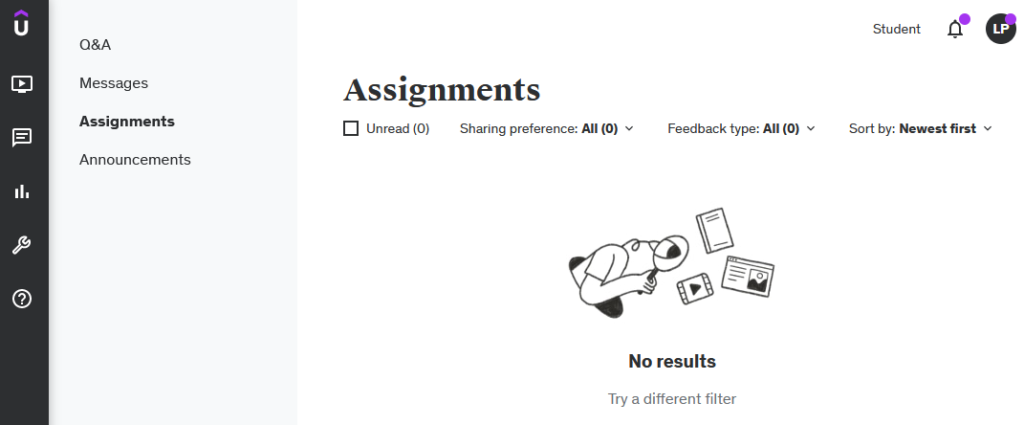
Landing page
The landing page in Udemy serves as the primary promotional space for your course, providing potential students with essential information such as the course description, the entry level of your course and the primary topic taught in the course.

To promote your course, you can add a course image and a promotional video, allowing potential students to preview what they will learn and gain insight into the course content.

Previewing your landing page allows you to see how your course details are showcased, including course descriptions, learning objectives, and student reviews (for existing courses). It’s crucial to ensure that your landing page effectively attracts and informs potential learners about the course content, its relevance to their interests or career goals, and the benefits they can expect from enrolling.

Course pricing
While you can offer your course for free, Udemy allows you to set a price from a range of tiers starting at $19.99 (Tier 1) and going up to $199.99 (Tier 29) once you have completed the premium application.

Submit Course for Review
In Udemy, before you can publish your course, you must go through a submission process where you verify your identity and ownership rights to the course content.
This involves confirming your identity to ensure authenticity and compliance with Udemy’s policies. You also need to provide your country of residence as part of this verification process. This ensures transparency and accountability in the content creation and publishing process on Udemy, maintaining trust and quality standards for both instructors and learners.

To complete your identity verification on Udemy, you’ll use Persona, a service that verifies your identity using local ID documents. If you’re representing a larger organization like a publisher, you’ll need to submit your personal information and ID as the designated account manager responsible for content and support activities.

Create Practice Test
Udemy lets you create courses that only contain practice tests.
Practice tests help students prepare for their certification exams by simulating the actual exam in both format and difficulty, ensuring they are well-prepared for the real test.
Creating practice tests is only available for paid courses, so you must first complete the premium application. In order to publish these practice test-only courses, you must include at least 2 practice tests, with a maximum of 6.
Define Your Learning Objectives
As with creating a course, when creating your practice tests, you need to specify at least four learning objectives outlining what learners will achieve and the skills they will acquire, provide the prerequisites for taking the practice test, and define the target audience. All this information will be visible on your course landing page.

Add Questions to Your Test
You have several options to add questions to your test, including multiple choice, multiple selection, fill in the blanks, and bulk upload.
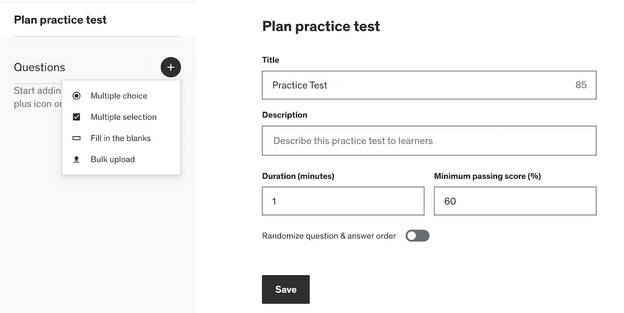
For multiple choice and multiple selection questions, you have to select the correct answers. For fill-in-the-blank questions, you will have to write the statement and format the blank field with two underscores surrounding the words, like this: __JavaScript__ is a programming language.
Each question requires an answer, and you can also add resources and explanations to enhance clarity. Udemy’s AI tool can assist in generating answers for these questions as well.

Bulk upload
Bulk upload in Udemy allows you, as an instructor, to efficiently add a large number of questions to your course tests. This feature is particularly useful for saving time when importing questions from external sources or when preparing comprehensive assessments quickly. You can upload questions in bulk from various file formats such as CSV files, making it easier to manage and organize extensive question banks for your courses.

Marketplace Insights
Udemy offers tools that assist in evaluating the competitiveness of your course topic. This information allows you to understand the level of competition in your chosen field, enabling you to make informed decisions about course content. This personalized approach helps you attract more students and enhancing the success of your course.
For your selected topic, you can view its statistics such as he student demand, or the median monthly revenue.

There is also a variety of charts that help you understand trends related to your chosen topic.

You can also check the existing courses on the topic you choose and review metrics related to the overall quality of these courses.

Pros and Cons
Final Thoughts on Udemy
Udemy offers a robust platform for both aspiring and experienced instructors to share their knowledge with a global audience. With its intuitive course creation tools, diverse content formats including videos, articles, quizzes, and coding exercises, and features like AI-generated content and competitive topic analysis, Udemy empowers instructors to create engaging and informative courses.
The ability to reach millions of learners worldwide through Udemy’s marketplace, combined with its supportive instructor community and mobile accessibility, makes it a compelling choice for educators looking to expand their reach and impact in the online learning landscape.
Get started creating courses with Udemy today!
Udemy Alternatives



